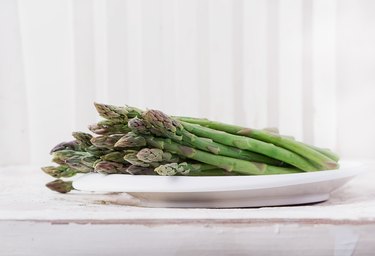
There are some vegetables you can't eat raw, but fortunately asparagus isn't one of them. Unlike potatoes or artichokes, asparagus is still easily digested when raw. Cooking helps soften the tough outer skin of asparagus so you'll need to take that into consideration when eating it raw. Keys to serving raw asparagus include choosing fresh and tender stalks, and getting rid of that tough outer layer.
Choose the Freshest Asparagus
Video of the Day
All varieties of asparagus can be eaten raw, so let your overall menu or availability dictate the color or colors you choose. Raw asparagus comes in white and purple varieties, as well as the traditional green.
Video of the Day
The thickness of the stalks has no bearing on how tender it is. That depends solely on the vegetable's maturity when harvested. Knowing how to pick the freshest asparagus makes eating it raw more appealing.
Check that the flower end is tightly closed to show that it's fresh. Check along the length of the stem for uniform color, without fades or streaks. Withered or overly limp stems can mean that the asparagus has passed its peak of freshness, as can a stem end that appears dried out.
Rinse and Slice the Stalks
Rinse the asparagus thoroughly in cool water. Either shake off the excess water or blot the spears dry with paper towels or a clean, lint-free kitchen towel. Slice off ¼ inch or so of the stem end. The flower end is tender and crisp no matter how thick the stalk is, so cut those off as well.
Peel the remaining stalk lengthwise to remove the tough and fibrous skin. Cut thin stalks into bite-sized pieces or leave them long as you prefer. Slice thicker stalks lengthwise with a very sharp paring knife, a vegetable peeler or mandoline, keeping the thickness as uniform as possible.
Add Seasonings and Serve
Any seasoning that complements cooked asparagus also works well with raw. The classic accompaniments are lemon juice and pepper. Shaved Parmesan adds a deep, savory note that brings out the earthiness in asparagus.
Toss raw asparagus with a dressing made of olive oil, lime juice, garlic salt, chili powder, cumin and thyme for a Southwestern treat. Add raw asparagus to cold pasta salads for an unexpected bit of crunch, or serve thin or slivered spears as a side dish with cold chicken or fish.
Shave Raw Asparagus
If you find pieces of asparagus spears too tough to eat, try shaving it into thin ribbons. The shaved slices are usually more tender than the spears.
All you need is a Y peeler. Run it along the stalk to shave the asparagus. Continue shaving the asparagus stalks until it's completely done.
The asparagus works well as a salad on its own with your choice of seasonings or dressings. You can also add the shaved asparagus to any green salad for extra flavor. Shaved asparagus also works as a substitute for pasta. Or top your favorite dishes, such as eggs, pizza or grains with the asparagus ribbons.
Store Unused Fresh Asparagus
A member of the lily family, asparagus stays fresh by storing as you would any flower with a cut stem. Trim the ends of the stalks and place the raw asparagus spears in a glass tall enough to support the stalks.
Fill the bottom inch or two of the glass with water. Place a plastic bag loosely over the top of the stalks and keep them in the refrigerator. This keeps your asparagus gorgeously crisp and fresh for up to three days.